Abstract
To observe the effects of dislocation density and crystal plane orientation on the migration of faceted boundaries, bi-layer BaTiO3 samples composed of single crystals with different surface orientations and dislocation densities and polycrystals with different average grain sizes were annealed in air for 24 h. The migration distance was highly dependent on the crystallographic plane of the migrating boundary, consistent with our previous investigation. For large driving force, the migration distance appeared to be linearly proportional to the driving force for the studied range, irrespective of the dislocation density, suggesting diffusion-controlled migration. For driving forces lower than a critical value, which varied with the crystallographic plane of the single crystal, the boundary did not migrate. At a driving force between that for the linear region and that for no migration region, the migration of a crystal with a high dislocation density was faster than that of a crystal with a low dislocation density. These results show a migration enhancement of the boundary by dislocations, in contrast to the conventional understanding of the dislocation energy effect on the driving force for boundary migration. The observed dislocation effect is the first demonstration of dislocation-enhanced migration of faceted boundaries in single phase systems.
1 Introduction
In the absence of surface defects, the growth of a faceted crystal from a solution or vapor occurs via the formation of nuclei [Citation1,Citation2], and the rate is governed by the competition of ripening and step nucleation [Citation3Citation[4]–Citation6]. When the driving force for crystal growth is smaller than the activation energy for step nucleation, the growth is practically inhibited. If steps associated with crystal defects are present at the facet surface, however, the crystal can grow under a driving force smaller than the activation energy. Surface defects thus promote the crystal growth [Citation7Citation[8]–Citation10]. Among crystal defects, screw dislocations are known to enhance the growth of a crystal via the spiral step growth mechanism [Citation11Citation[12]–Citation13]. Edge dislocations have also been suggested to enhance the crystal growth rate [Citation14Citation[15]–Citation16]. The enhancement of crystal growth with increasing dislocation density was also predicted and observed [Citation1,Citation11Citation[12]–Citation16]. In some systems of single crystal/polycrystal bi-layer samples with a liquid film between them, it was observed that the growth rate of a single crystal with a high dislocation density was higher than that with a low dislocation density [Citation17Citation[18]–Citation19]. These experimental results thus demonstrate the migration enhancement of a faceted solid/liquid interface by increased dislocation density.
Compared with the relatively solid understanding of the effects of dislocations on crystal growth from a solution, the effects of dislocations on the migration of grain boundaries are not well documented. Chung and Kang [Citation17] studied the effects of dislocations on grain boundary migration as well as solid/liquid interface migration in SrTiO3. They observed no appreciable effect of dislocations on boundary migration kinetics. This was tentatively attributed to the fairly low fraction of faceted boundaries (~35%) in the samples. They suggested conducting experiments using a system with fully faceted boundaries in order to reveal the effect of dislocations on the migration of faceted boundaries.
The presence of dislocations on a growing grain, however, has been thought to reduce the boundary migration [Citation20], because the driving force for migration is reduced due to an increase in strain energy by Gb2 with an extension of the length of a dislocation by a unit distance. (G is the shear modulus and b the Burgers vector.) Therefore, in view of the driving force, the migration rate of the boundary must be reduced in the presence of dislocations. In light of the migration mechanism of faceted boundaries, however, a different conclusion from that above can be drawn. Faceted boundaries with an atomically ordered structure have been suggested and observed to migrate with the step growth mechanism [Citation21Citation[22]–Citation24], which is similar to the 2-dimensional nucleation and growth of a crystal from a solution [Citation1,Citation2]. Experimental observations also showed that the grain growth is inhibited when the boundaries are faceted, indicating the presence of a critical driving force for the migration of faceted boundaries [Citation25Citation[26]–Citation27]. Indeed, our recent experiment demonstrated the presence of a critical driving force for the migration of a faceted boundary [Citation28]. These results suggest that the dislocations on the plane of a migrating boundary can provide atomic steps on the plane and enhance the boundary migration, similar to the enhanced migration of a faceted solid/liquid interface in the presence of surface dislocations [Citation11Citation[12]–Citation19].
The purpose of this work is to demonstrate the effect of dislocations on the migration of faceted singular boundaries with respect to the driving force. We took TiO2-excess BaTiO3 as a model system, where grain boundaries are fully faceted in air [Citation25,Citation26,Citation29]. Single crystal/polycrystal bi-layer samples with different dislocation densities on single crystal surfaces were prepared, as in our previous investigations on the effects of dislocations on solid/liquid interface migration [Citation17,Citation19]. The grain size in polycrystals was varied to observe the effect of the driving force on the migration of single crystal/polycrystal boundaries. It was shown that dislocations enhance the migration of faceted boundaries for a driving force smaller than a critical value.
2 Experimental procedure
Polycrystalline samples were prepared from commercial BaTiO3 (HPBT-1, 99.6% purity and <0.66 μm size, Fuji Titanium, Kanagaea, Japan) and TiO2 (99.9% purity and 0.4–0.8 μm size, Aldrich Chemical Co., Milwakee, USA) powders. 0.2 mol%-TiO2-added BaTiO3 powder was ball-milled in ethyl alcohol for 24 h using a polyethylene bottle and ZrO2 balls of 3 mm diameter. The dried powder slurry was crushed and passed through a 125 μm sieve. The powder was lightly pressed into disks of 10 mm diameter and ~3 mm height using a steel die and isostatically compressed at 200 MPa. The disks were calcined at 900 °C for 24 h and sintered at 1250 °C in H2 for various periods of time up to 10 h. The H2-sintered samples were resintered at 1290 °C for 30 min in air. The 2-dimensional average grain size and area faction of pores in the H2-sintered samples were measured on polished sections using an image analysis program (Matrox Inspector 2.1). More than 200 grains were measured for each sample. To measure the area fraction of pores in a polycrystal, polished planes were observed without etching.
Three sets of single crystal/polycrystal bi-layer samples with different orientations of single crystals, (1 0 0), (1 1 0), and (1 1 1) planes, were prepared. To introduce dislocations in the surface region of the single crystals, single crystal substrates of 10 mm × 10 mm × 1 mm (Ceracomp Co., Cheonan, Korea) were mechanochemically polished in a silicate solution. The substrate was cut into several pieces of 2 mm × 2 mm × 1 mm. Some of the pieces were annealed at 1300 °C for 48 h in air to reduce the dislocation density. The dislocations introduced to the surface region by mechanochemical polishing were observed under a transmission electron microscope (TEM; JEM-3010, JEOL, Tokyo, Japan) operated at 300 kV. For the TEM observation, the samples were cut into 3 mm discs, mechanically ground to a thickness of 100 μm, dimpled to a thickness of less than 10 μm, and finally ion-milled until there were perforations for electron transparency.
Single crystal pieces were bonded to the sintered polycrystalline disks that had been polished to a 1 μm finish, following the procedure described in our previous investigations [Citation28,Citation30]. The coupled single crystal pieces and polycrystal plates were embedded in 0.2 mol%-TiO2-added BaTiO3 powder, lightly pressed into pellets of 15 mm × 15 mm × 10 mm using a steel die, and then isostatically compressed at 200 MPa. The pellets were annealed at 1290 °C, below the eutectic temperature, for 24 h in air to induce growth of the single crystals into polycrystalline disks. After polishing and etching in a distilled HF and HCl solution, the growth layer was observed on a plane vertical to the sample of the single crystal.
3 Experimental results
During sintering of powder compacts in H2 the compacts were densified and the average grain size increased continuously as in our previous investigations [Citation25,Citation26,Citation28,Citation29]. shows the microstructures of the compacts sintered for various times in H2 and lists the average grain sizes of the sintered samples. The average size increased from 0.99 to 2.88 μm during sintering from 30 min to 600 min. During subsequent resintering of the H2-sintered samples at 1290 °C for 30 min in air, densification exceeded 90% relative density in all the samples, and the grain size increased slightly, as shown in the insets in . The microstructures, however, were essentially unchanged during extended sintering in air, as observed in our previous investigations [Citation25,Citation28,Citation31]. Such stagnation of the microstructure in the polycrystal samples at a high temperature in air was attributed to the change in the grain boundary structure from rounded to faceted in a short period of air annealing, and thus an increase in the critical driving force for boundary migration above the maximum driving force for the growth of the largest grain [Citation25,Citation26,Citation28].
Table 1 Measured migration distances of (1 1 0), (1 0 0) and (1 1 1) single crystals with high and low dislocation densities into polycrystals with different average grain sizes after annealing at 1290 °C for 24 h in air.
Fig. 1 Microstructures of 0.2 mol%-TiO2-excess BaTiO3 powder compacts sintered at 1250 °C for (a) 30 min, (b) 1 h, (c) 2 h, and (d) 10 h in H2. The insets show the microstructures of the same samples after annealing at 1290 °C for 30 min in air.
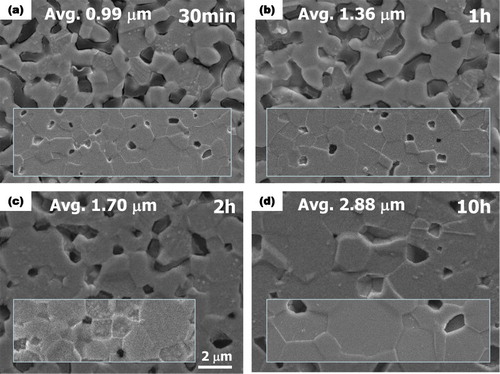
shows the etch pits at the surfaces of the mechano-chemically polished single crystals before (a) and after (b) annealing at 1300 °C for 48 h. The dislocation density in the surface region of the mechanochemically polished sample is apparently much higher than that after high temperature annealing, as the etch pits (circles) show. This observation indicates that dislocations were introduced during mechanochemical polishing and many of them were annealed out during the annealing at 1300 °C. These results are similar to previous results that showed the introduction of dislocations in SrTiO3 [Citation17,Citation32] and sapphire [Citation33] by mechanochemical polishing and high temperature deformation, respectively, and a reduction of the dislocation density during subsequent high temperature annealing [Citation33]. The dislocation introduced by the mechanochemical polishing, however, largely remained during the subsequent growth of the single crystal at 1290 °C for 24 h, as shown by the representative TEM micrographs in .
Fig. 2 Etch pits of the surface regions of the samples (a) without and (b) with annealing, respectively, at 1300 °C for 48 h in air.
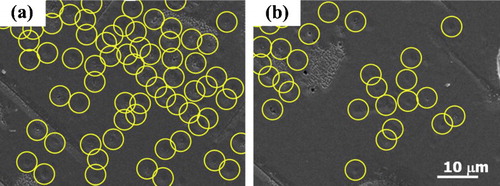
Fig. 3 TEM micrographs of (a) a surface region and (b) a grown layer of mechano-chemically polished single crystals before (a) and after (b) crystal growth at 1290 °C for 24 h.
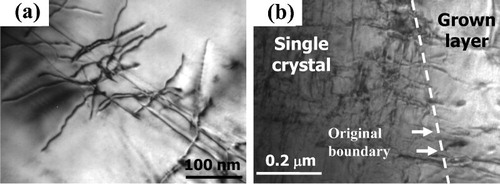
shows the layers grown from (1 1 0) planes of single crystal pieces with high ((a), (b), (c), and (d)) and low dislocation densities ((e), (f), (g), and (h)) into the polycrystal plates after annealing at 1290 °C for 24 h in air. In the samples with the smallest average size of matrix grains, the migration distances are the same for the samples with high and low dislocation densities. With increasing average grain size, i.e. with decreasing driving force, however, the migration distances decrease and deviate: longer distances are observed for high dislocation density than for low dislocation density. Further reduction of the driving force results in immobilization of the boundary. The boundary immobilization is observed at a lower driving force for high dislocation density than for low dislocation density.
Fig. 4 Growth of (1 1 0) crystals with a high ((a)–(d)) and a low dislocation density ((e)–(h)) into polycrystalline matrix with grains of 0.99 μm ((a) and (e)), 1.36 μm ((b) and (f)), 1.70 μm ((c) and (g)), and 2.88 μm ((d) and (h)) in average size. Samples were annealed at 1290 °C for 24 h in air.

shows the layers grown from (1 0 0) single crystal pieces. Unlike the samples with (1 1 0) single crystals, boundary migration occurs in all of the samples at much faster rates than in the samples with (1 1 0) boundaries. The dependence of the migration distance with respect to the dislocation density, however, is similar to that for a (1 1 0) single crystal. One feature to note for the (1 0 0) boundary is that the migrating boundaries are undulated (zigzagged). This indicates that the (1 0 0) plane is not a stable plane at the annealing temperature. An energetically unstable boundary would tend to dissociate into planes with lower energies. It appears, however, that the observed migrating boundary does not consist of specific planes, suggesting that a kinetic issue is involved in the shape of the migrating boundary.
Fig. 5 Growth of (1 0 0) crystals with a high ((a)–(d)) and a low dislocation density ((e)–(h)) into polycrystalline matrix with grains of 0.99 μm ((a) and (e)), 1.36 μm ((b) and (f)), 1.70 μm ((c) and (g)), and 2.88 μm ((d) and (h)) in average size. Samples were annealed at 1290 °C for 24 h in air.
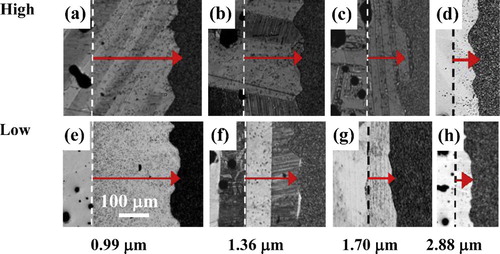
In contrast to the increased migrations of (1 0 0) and (1 1 0) boundaries with increasing driving force, the (1 1 1) plane did not move at all into the polycrystals, even with the highest driving force in this study, as shown, for example, in . This result shows that the (1 1 1) plane is the most stable plane among the studied planes. Indeed, below the eutectic temperature, the (1 1 1) plane was observed to be the most stable plane [Citation29,Citation34,Citation35]. This also confirms a strong dependence of the migration kinetics of the boundary on the crystallographic plane of the growing grain.
Fig. 6 (a) Low- and (b) high-magnification micrographs showing a non-migrating (1 1 1) boundary with a high dislocation density in a bi-layer sample containing a polycrystal of 0.99 μm average grain size after annealing at 1290 °C for 24 h in air. The uneven surface of the single crystal in (b) is due to a strong chemical etching.
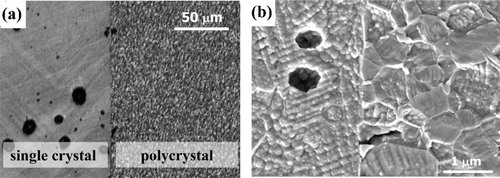
Comparing –, the following distinctive features can be observed:
| (i) | longer migration distances for samples with a higher dislocation density under driving forces below a critical value (the critical value is different for high and low dislocation densities); | ||||
| (ii) | almost the same migration distances regardless of the dislocation density for driving forces larger than the critical value; | ||||
| (iii) | the presence of a critical driving force for migration, which is highly dependent on the crystallographic plane of the migrating boundary, in particular for the (1 1 0) and (1 1 1) boundaries; and | ||||
| (iv) | different shapes of migrating boundaries between the (1 0 0) and (1 1 0) planes. | ||||
4 Discussion
lists the measured migration distances of single crystals with (1 0 0) and (1 1 0) planes after annealing at 1290 °C for 24 h. (The values in the parentheses show the distances measured in repeated experiments at the given conditions.) Because of the limitation of single crystal size, not all of the data can be confirmed; however, the selected repetition of experiments confirms the experimental reliability fairly well. plots the migration distances of the single crystals as a function of the inverse of the average grain size for the (1 1 0) plane (a) and for the (1 0 0) plane (b). It is obvious that the migration behavior of the boundaries is nonlinear with respect to the driving force, similar to observations in our previous investigation [Citation28].
Fig. 7 Migration distances of (a) (1 1 0) and (b) (0 0 1) planes as a function of the inverse of average grain size after annealing the bi-layer samples at 1290 °C for 24 h in air. Dashed and solid curves are for single crystals with a high and a low dislocation density, respectively.
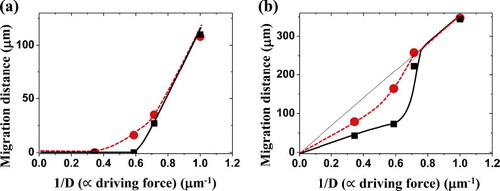
The drastic difference in migration kinetics among the (1 0 0), (1 1 0), and (1 1 1) planes may be either due to a difference in the driving force (boundary energy) or to a difference in kinetic attachment of atoms on a single crystal plane (interface reaction), or both. The difference in boundary energy in perovskites, known to be within a range of a few times from boundary to boundary [Citation36,Citation37], cannot adequately explain the differences in migration kinetics and behavior among planes [Citation28]. In particular, the observed immobility of the (1 1 1) boundary cannot be explained by the difference in driving force. As explained in our previous investigation [Citation28], there is always a finite driving force for the crystal growth even in the presence of pore drag, if the polycrystals have similar microstructures. If the driving force was the main cause of the difference in migration kinetics, the (1 1 1) boundary should also have migrated, in contrast to the present observation. This result confirms that the nonlinear migration of a faceted boundary below a critical driving force is largely governed by the interface reaction.
For a nonlinear region in the plot of the migration distance vs. the driving force, the difference in migration distance between the samples with high and low dislocation densities, clearly shows increased migration with an increased dislocation density, and hence an enhancement of boundary migration by dislocations. The dislocation-enhanced boundary migration, however, cannot be explained in terms of the difference in the driving force for the migration. The driving force for boundary migration must be the difference between the capillary driving force and the strain energy stored by dislocations. Therefore, the driving force for the sample with a high dislocation density must be lower, although not significantly so, than that for the sample with a low dislocation density [Citation20]. The reduction of the driving force for boundary migration (ΔE) by dislocations with a density of n, ΔE = nGb2, is estimated to be 10−2 to 10−1 J/mol. For the estimation, n was assumed to be 108 to 109/cm2, a value reported for a highly deformed alumina [Citation33], G to be 150 GPa and b to be 0.476 nm. In contrast, the capillary driving force for boundary migration is estimated to be 18–50 J/mol, using boundary energy of 0.3 J/m2, a molar volume of 3.85 × 10−5 m3/mol and a 2-dimensional grain size of 0.99–2.88 μm. These estimations indicate that for the studied range of experimental conditions, the difference in the driving force between the samples with high and low dislocation densities is inconsiderable.
Some previous investigations [Citation38,Citation39] reported a case of dislocation-related boundary migration. In particular, it was shown that the boundary of a cubic zirconia bi-crystal moved under compression as a result of the movement of dislocations toward the boundary, and their climb and glide at the boundary [Citation39]. This result suggests the dislocation density-dependent migration of the grain boundary. The boundary migration, however, resulted from dislocation movement under compression. Without external stress and, hence, with no dislocation glide and climb, the dislocation density is not expected to affect the boundary migration. The presently observed migration enhancement of grain boundaries, however, is clearly not related to the dislocation movement.
The present migration enhancement of the (1 1 0) and (1 0 0) boundaries by dislocations is believed to related to the migration behavior of faceted boundaries. According to previous investigations [Citation22Citation[23]–Citation24,Citation40], the migration of a faceted boundary occurs via the formation of steps on a flat boundary and their subsequent growth, that is, a step growth (or atom shuffle) mechanism. This migration behavior is similar to that of a faceted solid/liquid interface via the formation of 2-dimensional nucleation and growth [Citation1,Citation2,Citation41]. In addition, the migration of a faceted boundary was observed to be non-linear with respect to the driving force [Citation28], similar to that of a faceted solid/liquid interface. It is therefore expected that the effect of dislocations on the migration of a faceted boundary is similar to that of a faceted solid/liquid interface.
It is well documented in the literature that the growth of a faceted crystal in a liquid is promoted by screw dislocations with the provision of ledges and kinks at the singular surfaces [Citation1,Citation2]. Edge dislocations were also suggested to promote the crystal growth [Citation14Citation[15]–Citation16]. Experimental results [Citation12] also support the theoretical prediction. It is therefore concluded that the dislocations on a migrating faceted boundary provide additional steps for easy attachment of atoms and thus promoted the boundary migration, characteristic of the step growth of the boundary [Citation21].
At high driving forces with small average grain sizes of polycrystals, however, the promotion effect of dislocations disappears. This shows that under high driving forces, the migration is not governed by the number of sites for easy attachment of atoms, but by the absolute value of the driving force and hence the diffusion of atoms across the boundary. Such a migration behavior is similar to the linear increase of the migration rate of a faceted solid/liquid interface under driving forces larger than a critical value [Citation12,Citation41].
The difference in shape between the migrating (1 0 0) and (1 1 0) planes must reflect the stability of the boundaries. The stability of a boundary can be evaluated by using the concept of the ξ-vector (the capillary vector, including grain boundary tension (γ) and torque (dγ/dφ), which tends to rotate the boundary plane) [Citation42,Citation43]. The ξ-vector was originally proposed by Hoffmann and Cahn [Citation42] for a faceted surface as an alternative to the γ-plot and later applied to the grain boundary by King [Citation44]. Through a computer simulation (with embedded-atom potential), Wolf et al. [Citation45] showed the possibility that a low index plane can form singular grain boundaries with high index planes. Recent experimental measurements [Citation46Citation[47]–Citation48] support the theoretical prediction. In BaTiO3, (1 1 1)/(hkl) grain boundaries were frequently observed during grain growth below the eutectic temperature and the boundary planes were maintained upon further annealing even for two connected (1 1 1)/(hkl) boundaries [Citation34,Citation35,Citation49]. These observations indicate that the (1 1 1)/(hkl) grain boundary has a deep cusp in the Wulff plot and a wide ξ-fan.
For our (1 1 0)/(hkl) boundary, a straight boundary shape was maintained during the crystal growth, implying that the boundary has a deep cusp, as in the case of the (1 1 1)/(hkl) boundary. The torque (dγ/dφ) in the ξ-vector must act as a force to maintain the low index (1 1 0) plane. The undulation of the (1 0 0)/(hkl) boundary during its migration, on the other hand, indicates that the energy cusp is not deep enough to maintain its original shape during the migration. As the crystallographic planes of the matrix grains meeting with a (1 1 0) or (1 0 0) single crystal can be considered to be the same, on average, the two different shapes of the migrating boundaries, straight and undulated, show that the depth of the energy cusp is mainly governed by the single crystal orientation. This is consistent with the results of grain boundary character distributions of MgO [Citation46].
The immobility of the boundary, in particular the (1 1 1) boundary, below a critical value of the driving force is quite peculiar. If the migration mechanism of a faceted boundary in the presence of dislocations is the same as that of a faceted solid/liquid interface, the migration rate should exhibit a parabolic dependence on the driving force without showing a critical driving force for migration.
The present results, however, suggest that the critical driving force for migration increases as the energy of the migrating plane decreases, which implies an increase in the step free energy of the boundary. Hence, the present result may suggest that the step free energy of the migrating plane affects the migration behavior and kinetics even in the presence of dislocations. As the grain boundary is an interface bounded by triple junction lines between two grains, the movement of atoms between the two adjacent grains would not be as simple as that between two grains immersed in a liquid. This issue, however, has not yet been studied and should be addressed in the future.
5 Conclusions
The effect of dislocations on the migration of faceted boundaries with respect to the driving force has been studied. Single crystal/polycrystal bi-layer samples were prepared with different dislocation densities in single crystals and with different average grain sizes in polycrystals. The migration kinetics was very different for single crystals with different crystallographic orientations. Single crystals with (1 0 0) and (1 1 0) planes migrated into polycrystals while single crystals with a (1 1 1) plane did not migrate at all for the studied range of experimental conditions. A critical driving force, which varied with the crystallographic plane, exists for the immobilization of the boundary. For low driving forces above the critical value, the migration rate was enhanced with the introduction of dislocations in the surface region of the single crystal. For high driving forces, the migration rates of single crystals with high and low dislocation densities were the same.
The observed dislocation-enhanced boundary migration for low driving forces is the first demonstration of the effect of dislocation on the migration of faceted boundaries in single phase systems. The independency of the migration rate on the dislocation density for high driving forces suggests that if the driving force is larger than a critical value, the migration of a faceted boundary is not governed by the attachment of atoms on faceted planes with defects but by the diffusion of atoms across the boundary. The critical driving forces for boundary immobilization and for diffusion-controlled migration were different from boundary to boundary. It appears that the step free energy of the plane also plays a role in addition to the role of dislocations. This issue, however, has not yet been studied.
Acknowledgements
This work was supported by the Priority Research Centers Program through the National Research Foundation of Korea (NRF) funded by the Ministry of Education, Science and Technology (MEST) (No. 2012-0005707) and also by the Samsung Electro-Mechanics Co. Ltd. through the Center for Advanced MLCC Manufacturing Processes.
Notes
Peer review under responsibility of The Ceramic Society of Japan and the Korean Ceramic Society.
References
- W.K.BurtonN.CabreraF.C.FrankPhilos. Trans. R. Soc. Lond. A2431951299358
- J.P.HirthG.M.PoundProgress in Materials Science: Condensation, Evaporation1963Pergamon PressOxford
- P.WynblattN.A.GjosteinActa Metall. Mater.24197611651174
- W.JoD.Y.KimN.M.HwangJ. Am. Ceram. Soc.89200623692380
- Y.I.JungD.Y.YoonS.-J.L.KangJ. Mater. Res.24200929492959
- S.-J.L.KangM.G.LeeS.M.AnJ. Am. Ceram. Soc.92200914641471
- R.S.WagnerActa Metall. Mater.819605760
- D.R.HamiltonR.G.SeidenstickerJ. Appl. Phys.31196011651168
- H.J.ScheelD.ElwellJ. Cryst. Growth201973259267
- H.SchmelzA.MeyerCeram. Forum Int. Ber. Dtsch. Keram. Ges.591982436440
- F.C.FrankDiscuss. Faraday Soc.519494854
- S.D.PetevesR.AbbaschianMetall. Trans. A22199112591270
- K.MaiwaM.PlompW.J.P.Van EnckevortP.BennemaJ. Cryst. Growth1861998214223
- E.BauserH.StrunkJ. Cryst. Growth511981362366
- F.C.FrankJ. Cryst. Growth511981367368
- E.BauserH.StrunkThin Solid Films931982185194
- S.Y.ChungS.-J.L.KangActa Mater.51200323452354
- J.H.BackM.J.KimD.Y.YoonJ. Am. Ceram. Soc.88200531773183
- M.S.KimJ.G.FisherS.-J.L.KangH.Y.LeeJ. Am. Ceram. Soc.89200612371243
- K.LückeK.DetertActa Metall. Mater.51957628637
- H.GleiterActa Metall. Mater.171969565573
- T.KizukaPhilos. Mag. Lett.791999417422
- K.L.MerkleL.J.ThompsonMater. Lett.482001188193
- K.L.MerkleL.J.ThompsonF.PhillippPhys. Rev. Lett.882002225501
- S.Y.ChoiS.-J.L.KangActa Mater.52200429372943
- Y.I.JungS.Y.ChoiS.-J.L.KangActa Mater.54200628492855
- E.A.HolmS.M.FoilesScience328201011381141
- S.M.AnB.K.YoonS.Y.ChungS.-J.L.KangActa Mater.60201245314539
- B.K.LeeS.Y.ChungS.-J.L.KangActa Mater.48200015751580
- S.Y.ChoiD.Y.YoonS.-J.L.KangActa Mater.52200437213726
- M.G.LeeS.Y.ChungS.-J.L.KangActa Mater.592011692698
- R.WangY.ZhuS.M.ShapiroPhys. Rev. Lett.80199823702373
- A.NakamuraK.P.D.LagerlöfK.MatsunagaJ.TohmaT.YamamotoY.IkuharaActa Mater.532005455462
- S.B.LeeW.SigleM.RühleActa Mater.50200221512162
- S.ZhengX.L.MaT.YamamotoY.IkuharaActa Mater.61201322982307
- S.HuttS.KöstlmeierC.ElsässerJ. Phys.: Condens. Matter13200139493960
- R.I.EglitisD.VanderbiltPhys. Rev. B762007155439
- A.D.Sheikh-AliActa Mater.45199731093114
- H.YoshidaK.YokoyamaN.ShibataY.IkuharaT.SakumaActa Mater.52200423492357
- S.G.SongPhilos. Mag. Lett.791999511517
- S.D.PetevesR.AbbaschianMetall. Trans. A22199112711286
- D.W.HoffmanJ.W.CahnSurf. Sci.311972368388
- J.W.CahnD.W.HoffmanActa Metall. Mater.22197412051214
- A.KingInterface Sci.71999251271
- U.WolfP.GumbschH.IchinoseH.F.FischmeisterJ. Phys (France)511990C1, 359366
- D.M.SaylorA.MorawiecG.S.RohrerJ. Am. Ceram. Soc.85200230813083
- D.M.SaylorB.S.El DasherA.D.RollettG.S.RohrerActa Mater.52200436493655
- G.S.RohrerJ.LiS.LeeA.D.RollettM.GroeberM.D.UchicMater. Sci. Technol.262010661669
- B.K.LeeS.-J.L.KangActa Mater.49200113731381